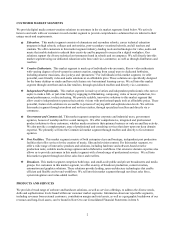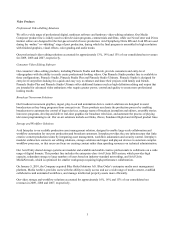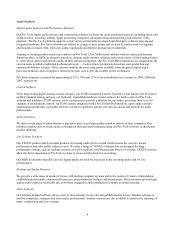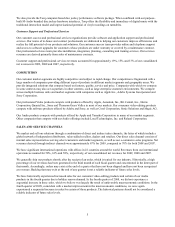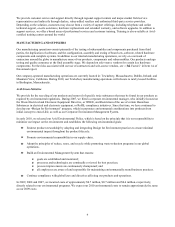Avid 2009 Annual Report Download - page 17
Download and view the complete annual report
Please find page 17 of the 2009 Avid annual report below. You can navigate through the pages in the report by either clicking on the pages listed below, or by using the keyword search tool below to find specific information within the annual report.12
Our future results could be materially adversely affected if we are accused of or found to be infringing third parties’
intellectual property rights.
Because of technological change in our industry, extensive and sometimes uncertain patent coverage, and the rapid issuance
of new patents, it is possible that certain of our products or business methods may inadvertently infringe the patents or other
intellectual property rights of third parties. Third parties contact us from time to time alleging that our products infringe
their intellectual property rights. Allegations from opportunistic patent owners often lack merit and are undertaken with the
goal of inducing the alleged infringer into a quick settlement to thereby spare the alleged infringer the nuisance and expense
of legal discovery and a trial. Our general practice is to mount a vigorous defense against any claim that we believe lacks
merit and eschew a quick settlement. This practice may cause us to incur significant legal defense costs that could have a
negative impact on our operating results. With respect to legitimate allegations, our general practice is to negotiate licenses
to the patented inventions as appropriate, which may include back-royalties to compensate for past use or distribution of the
patented invention. Additional royalties will increase our cost-of-goods-sold and reduce our operating results. To the extent
licenses are not available to us on commercially reasonable terms or at all, we may be required to expend considerable time
and resources to develop a non-infringing alternative. In the interim, sales of our products may be delayed or suspended or
we may be forced to distribute our products with reduced feature sets or functionality.
In addition to allegations made directly against us, in some cases we have indemnification obligations with respect to
claims of infringement made against our customers and other related parties. A broadly targeted claim of infringement
made against our customers or other related parties may result in significant defense costs for us.
Our intellectual property and trade secrets are valuable assets that may be subject to third-party infringement and
misappropriation.
As a technology company, our intellectual property and trade secrets are among our most valuable assets. Infringement or
misappropriation of these assets results in lost revenues to us and thereby ultimately reduces their value. We rely on a
combination of patent, copyright, trademark and trade secret laws, as well as confidentiality procedures, contractual
provisions and anti-piracy technology in certain of our products to protect our intellectual property and trade secrets. Most
of these tools require vigilant monitoring of competitor and other third-party activities and of end-user usage of our
products to be effective. These tools may not provide adequate protection in all instances, may be subject to circumvention,
or may require a vigilance that in some cases exceeds our capabilities or resources. Additionally, the legal regimes of
certain countries in which we operate may not protect our intellectual property or trade secrets to the same extent as do the
laws of the United States. Regardless of jurisdiction, assuming legal protection exists and infringement or misappropriation
is detected, any enforcement action that we may pursue could be costly and time-consuming, the outcome will be uncertain,
and the alleged offender in some cases may seek to have our intellectual property rights invalidated.
Our revenues and operating results depend significantly on our third-party reseller and distribution channels.
We distribute many of our products indirectly through third-party resellers and distributors. Relatively few resellers and
distributors account for a significant portion of our consumer revenues. The loss of one or more of these or other key
resellers or distributors may significantly reduce our revenues. To the extent we distribute our products directly to end-user
customers, we may be in competition with our resellers and distributors. In response to our direct sales strategies or for
other business reasons, our current resellers and distributors may from time to time choose to resell our competitors’
products in addition to, or in place of, ours. Certain of our resellers and distributors have limited rights of return, as well as
inventory stock rotation and price protection. Accordingly, reserves for estimated returns and exchanges, and credits for
price protection, are recorded as a reduction of revenues upon applicable product shipment, and are based upon our
historical experience. To date, actual returns of relevant products have not differed materially from our management’s
estimates. To the extent that returns exceed estimates, our revenues and operating results may be adversely affected.


